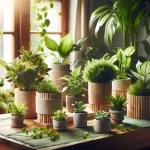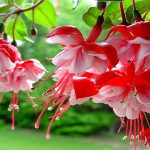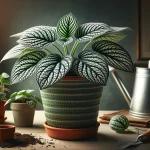This post may contain affiliate links. If you buy something from one of our links we may earn a commission. Thanks
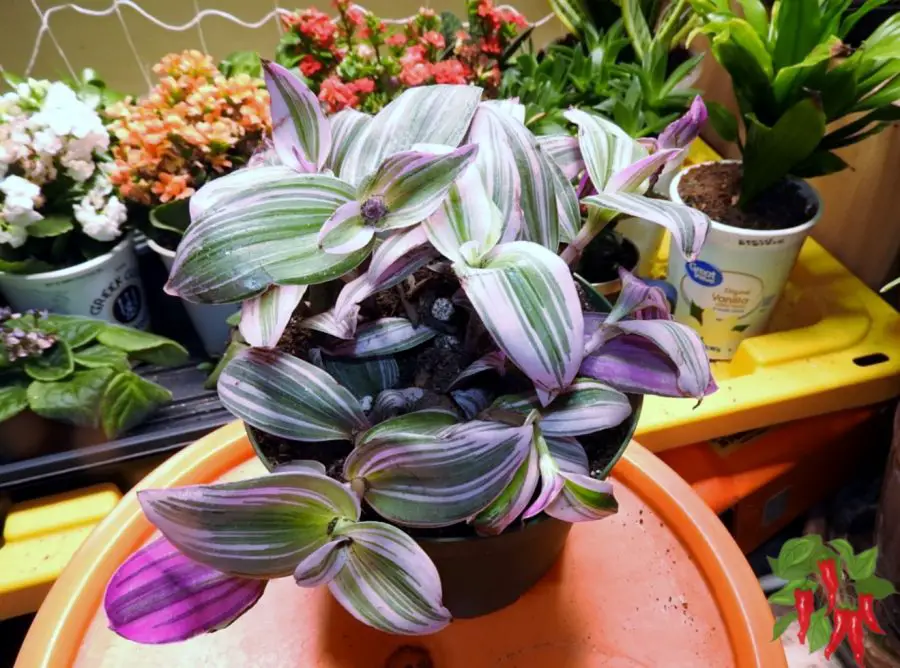
Nanouk Pink Wandering Jew care is simple and the payoff is gorgeous. With just a little love and the right setup, this bold, colorful plant will thrive indoors and brighten any room.
You’re in the right place if you’re after a low-fuss houseplant that turns heads.
Nanouk Pink Wandering Jew Care Key Takeaways
- Nanouk Pink Wandering Jew care involves giving your plant 6-8 hours of bright, indirect light
- Keep the soil lightly moist, and use well-draining soil like coco coir.
- Keep it in temperatures between 55–75°F with moderate humidity.
- Prune leggy stems and feed monthly during the growing season.
- Keep it out of reach of pets and kids.
Nanouk Pink Wandering Jew Care: Complete Power Guide
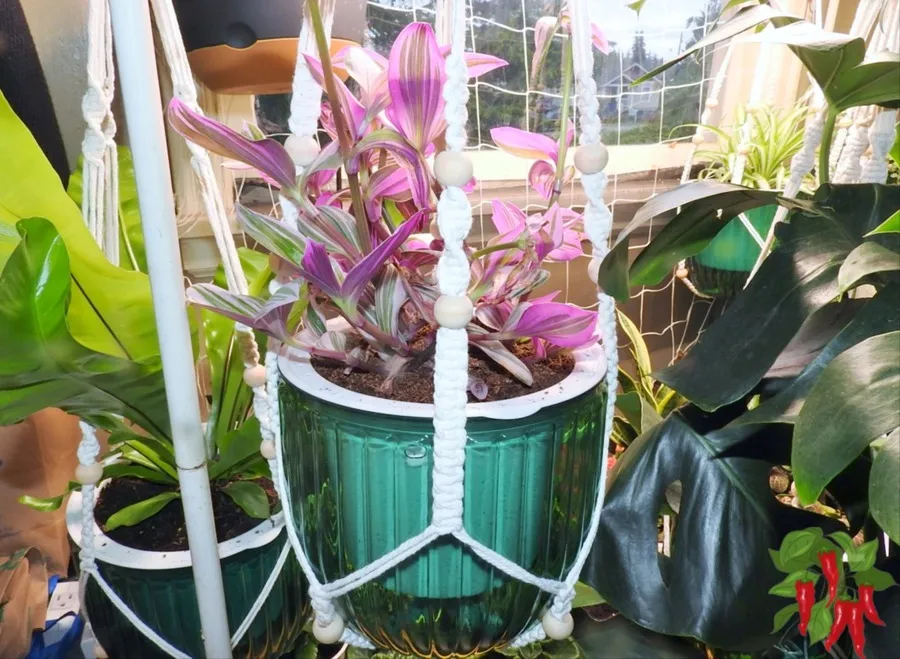
🌿 Meet the Tradescantia Nanouk
Also known as the Nanouk Pink Wandering Jew, this striking houseplant is part of the Spiderwort family and a total showstopper indoors.
Originally bred for durability and color, it’s one of the most vibrant and easy-to-love varieties in the Tradescantia family.
- Known by the nickname “Fantasy Venice”
- Grows well in small pots or hanging baskets
- Perfect for shelves, windowsills, and plant walls
🎨 A Pop of Color for Any Room
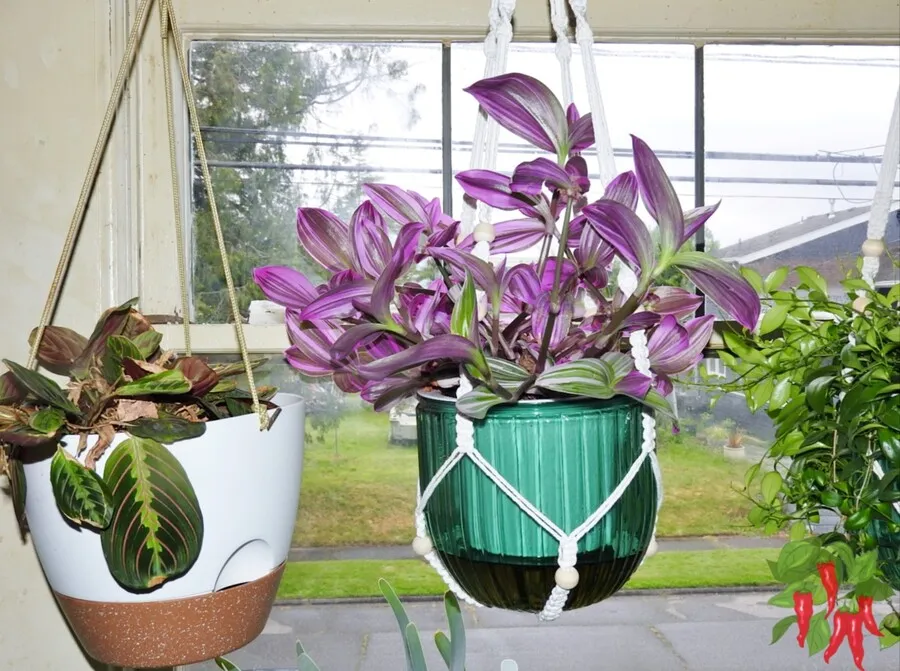
What makes this plant truly special is its eye-catching variegation. Each leaf is a little work of art with stripes of pink, purple, and green. When given the right light, those colors really pop!
- Bright pink and purple stripes with green edges
- Leaves grow thick and slightly fuzzy to the touch
- Adds a playful, tropical feel to indoor spaces
💪 Low-Maintenance Beauty
Don’t let those vibrant colors fool you—this plant is surprisingly easygoing. Tradescantia Nanouk is a great choice for beginners or anyone looking for a splash of color without a ton of upkeep.
- Only needs bright, indirect light to thrive
- Handles occasional missed waterings like a champ
- Grows fast and is easy to prune or propagate
Ready to dive in? Let’s walk through everything you need to keep your Nanouk looking its best.
🛒 Ready to Grow Your Own?
Love the look of this plant? You can grab a Nanouk Pink Wandering Jew online and have it delivered right to your door. It’s a beautiful, low-maintenance addition to any space and a great starter plant if you’re just getting into indoor gardening.
👉 Shop Nanouk Pink Wandering Jew on Amazon and bring home some bold, beautiful color today!
☀️ Nanouk Pink Wandering Jew Care and Optimal Growing Conditions
💡 Light Requirements
Your Nanouk Pink Wandering Jew loves the light—but not just any kind.
- Aim for 6–8 hours of bright, indirect sunlight every day
- An east-facing window is ideal: soft morning sun without harsh rays
- Too much direct light can burn or fade those pretty leaves
- In low light, the pink and purple tones may fade, leaving mostly green
If your plant starts stretching or looks dull, it’s asking for more light. Just keep it out of the hot afternoon sun and it’ll bounce back beautifully.
🌡️ Temperature and Humidity
🌬️ Keep It Cozy and Comfortable
Nanouk Pink Wandering Jew feels right at home in the same temps you do.
- Best range: 55–75°F (13–24°C)
- Keep it away from cold drafts or vents
- Avoid letting it drop below 50°F for too long
💧 Give It the Humidity Boost It Loves
This plant thrives with moderate to high humidity, just like its tropical roots expect.
- Use a small humidifier nearby during dry winter months
- Try a pebble tray with water under the pot (just don’t let the roots sit in it)
- Misting can help, but don’t overdo it—too much moisture on the leaves can cause issues
When the air’s a bit too dry, your Nanouk may get crispy tips or dull leaves. Bump up the humidity, and those colors will stay lush and vibrant.
🪴 Soil and Potting
🌱 The Right Mix Makes All the Difference
Nanouk Pink Wandering Jew doesn’t like wet feet, so drainage is key.
- Use a well-draining potting mix—something light and airy
- I use coco coir for moisture retention without sogginess
- Add perlite to boost drainage and keep roots happy
💐 Smart Potting for Easy Care
Choosing the right pot helps avoid common watering problems.
- Self-watering pots work great, especially if you travel or forget to water
- Always pick a pot with drainage holes—this plant hates sitting in soggy soil
- When in doubt, go one size up if roots are circling the bottom
A breathable potting mix plus a good container means less guesswork and a healthier plant. Your Nanouk will thank you with faster growth and bolder colors.
💧 Watering Practices
🚿 How and When to Water Right
Nanouk Pink Wandering Jew likes a steady rhythm when it comes to watering.
- Check the soil often—water when the top inch feels dry
- Aim to keep the soil evenly moist, not bone dry or soggy
- Always drain excess water—never let it sit in the bottom of the pot
- Self-watering pots are a great option to avoid over- or underwatering
Using a self-watering pot takes the guesswork out of the routine. It delivers moisture as the plant needs it, keeping your Nanouk happy and your watering schedule stress-free.
🌼 Fertilization
🌿 Light Feeding for Bold Growth
Nanouk Pink Wandering Jew isn’t a heavy feeder, but a little boost goes a long way during its active growing season.
- Feed once a month in spring and summer
- Use a balanced liquid fertilizer like 10-10-10, diluted to half strength
- Skip feeding in fall and winter when the plant slows down
Too much fertilizer can lead to salt buildup or weak, leggy growth. Keep it light and consistent, and you’ll see vibrant leaves and steady new growth.
✂️ Pruning and Maintenance
🌱 Keep It Full, Fresh, and Flowing
A little grooming goes a long way with your Nanouk Pink Wandering Jew. Regular maintenance keeps it looking lush and lively.
- Prune leggy stems to encourage fuller, bushier growth
- Snip off yellow or damaged leaves as soon as you see them
- Give it an occasional trim to keep its shape and prevent it from getting unruly
Don’t toss those cuttings—this plant roots easily in water or soil, so you can grow more from what you snip.
🌿 Propagation Methods
🌱 Snip, Root, Repeat
Nanouk Pink Wandering Jew is one of the easiest houseplants to multiply—perfect if you want to share or fill out your pot.
- Take a few healthy stem cuttings just below a node
- Place them in water or moist soil to root—both work great
- Roots develop fast, and new growth follows soon after
- Once rooted, transplant into a pot and watch it grow
It’s a fun way to grow your collection or pass along a piece of your plant to a friend. Just snip, root, and enjoy!
🪴 Repotting Your Nanouk Pink Tradescantia
🔄 When and How to Repot Your Nanouk
Tradescantia Nanouk grows quickly, so it’s a good idea to check the roots once or twice a year. If it’s looking cramped, it’s time to give it a little more room to stretch.
- Repot every 1–2 years or when roots circle the bottom of the pot
- Choose a pot that’s 1–2 inches wider than the current one
- Use fresh, well-draining soil—a mix of coco coir and perlite works great
- Gently loosen the roots before placing in the new pot
- Water lightly after repotting to help the plant settle in
Repotting keeps your Nanouk healthy and growing strong—and it’s a great chance to freshen up the soil and check for any root issues.
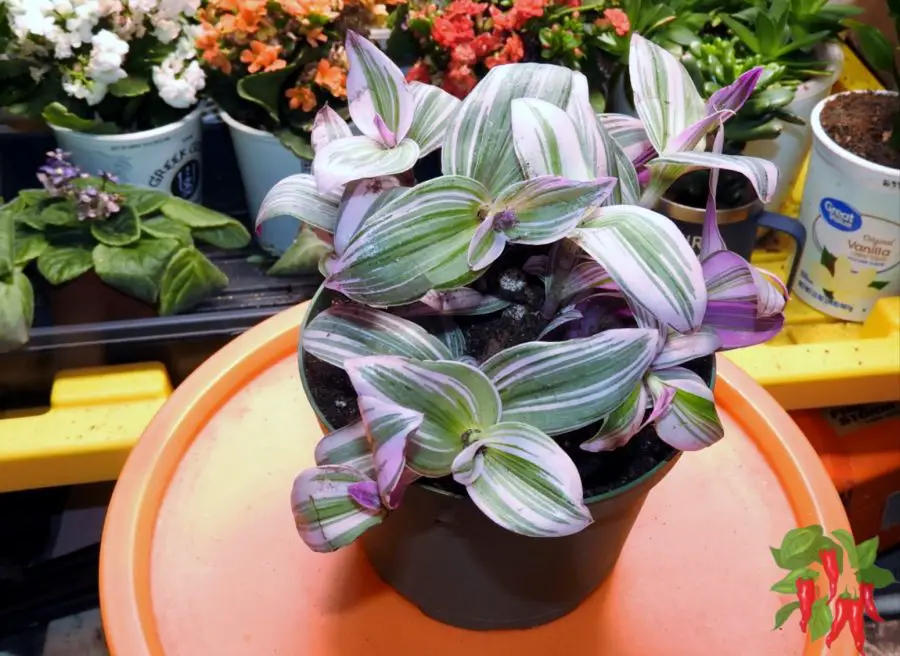
Nanouk Tradescantia Plant Care Reference Guide
| Characteristic | Details |
|---|---|
| Common Name | Nanouk Pink Wandering Jew |
| Botanical Name | Tradescantia albiflora ‘Nanouk’ |
| Native Habitat | Hybrid cultivar, originally bred in the Netherlands |
| Plant Type | Evergreen perennial, houseplant |
| Growth Pattern | Trailing or spreading |
| Mature Size | 4–6 inches tall, 12–18 inches wide |
| Watering | Water when the top inch of soil is dry; evenly moist but not soggy |
| Light/Sun Exposure | Bright, indirect light (6–8 hours daily) |
| Soil Type | Well-draining mix with coco coir and perlite |
| Soil pH | Slightly acidic to neutral (6.0–7.0) |
| Temperature | 55–75°F (13–24°C) |
| Humidity | Moderate to high; benefits from humidifiers or pebble trays |
| Bloom Time & Flower Color | Occasional small white or pinkish flowers |
| Potential Problems | Spider mites, root rot, leaf fade from low light |
| Repotting | Every 1–2 years or when rootbound |
| Hardiness Zones (USDA) | 10–12 (typically grown indoors) |
🛠️ Common Issues and Solutions
🚨 Keep Your Plant Happy and Problem-Free
Even though Nanouk Pink Wandering Jew is pretty low-maintenance, a few things can throw it off. Here’s what to watch for and how to fix it.
- Pests: Watch for spider mites or aphids—wipe leaves and use insecticidal soap or neem oil if needed
- Root Rot: Caused by soggy soil—make sure your pot drains well and never stays waterlogged
- Fading Color: If the pinks and purples start to fade, your plant probably needs more light
Stay ahead of these common issues and your Nanouk will stay colorful, healthy, and thriving.
⚠️ Safety Considerations
🐾 Better Safe Than Sorry
As beautiful as it is, the Nanouk Pink Wandering Jew isn’t safe for everyone in the house.
- Toxic to pets like cats and dogs if chewed or ingested
- Likely unsafe for small children—can cause irritation or stomach upset
- Keep it on a high shelf or in a hanging basket to stay out of reach
It’s a good idea to treat this plant like any other pretty-but-potent houseplant—admire it, but keep it up and out of the way.
🌟 Nanouk Pink Wandering Jew Care Conclusion
🌼 Wrapping It Up
Nanouk Pink Wandering Jew care is easier than it looks, and the results are worth it.
With just a little attention, this colorful beauty will reward you with bold foliage, steady growth, and plenty of personality.
It’s the kind of plant that makes your space feel more alive—with hardly any fuss.
Indoor Apartment Gardening: 15 Point Comprehensive Guide
📝 Quick Recap: How to Keep Your Nanouk Happy
Caring for your Nanouk Pink Tradescantia is simple when you stick to the basics:
- Light: Bright, indirect sunlight for 6–8 hours a day
- Water: Keep soil evenly moist, but never soggy
- Soil: Well-draining mix with coco coir and perlite
- Humidity: Moderate to high—boost it in dry seasons
- Feeding: Monthly in spring and summer with diluted fertilizer
- Pruning: Trim leggy stems and yellow leaves to shape it up
- Propagation: Root cuttings in water or soil to grow more
- Safety: Keep out of reach of pets and little ones
🌈 Enjoy the Color and the Calm
This plant brings a burst of personality to any indoor space. With minimal effort, you’ll be rewarded with bold color, fast growth, and an all-around cheerful vibe.
Add a Nanouk to your collection or a few more if you’ve started propagating and keep your space looking vibrant and fresh!
🛒 Ready to Grow Your Own Nanouk Tradescantia?
Love the look of this plant? You can grab a Nanouk Pink Wandering Jew online and have it delivered right to your door.
It’s a beautiful, low-maintenance addition to any space and a great starter plant if you’re just getting into indoor gardening.
Visit my Amazon Influencer Page for videos and gardening products
Grow Your Own Garden
❓ FAQ: Nanouk Pink Wandering Jew Care
🌿 Got Questions? We’ve Got Answers
Whether you’re just starting out or already growing a thriving Tradescantia Nanouk, a few questions always pop up. Here’s a quick guide to help you troubleshoot and grow with confidence.
Q. How often should I water my Nanouk Pink Wandering Jew?
A. Water when the top inch of soil feels dry. Keep the soil evenly moist but not soggy. Self-watering pots can help maintain the right balance.
Q. Why are the colors on my Nanouk fading?
A. Faded color usually means the plant isn’t getting enough light. Move it to a spot with more bright, indirect sunlight to bring those pink and purple tones back.
Q. Can I grow Nanouk Pink Wandering Jew in low light?
A. It can survive in low light, but the colors will fade and the plant may get leggy. Bright, indirect light is best for healthy growth and vivid color.
Q. Is Tradescantia Nanouk safe for pets?
A. No, it’s toxic to cats and dogs if ingested. Keep it out of reach, preferably in a hanging basket or on a high shelf.
Q. How do I make my Nanouk bushier?
A. Prune leggy stems regularly. This encourages the plant to branch out and grow fuller. You can also replant stem cuttings to fill out the pot.
Q. Can I propagate this plant in water?
A. Yes! Just snip a healthy stem below a node and place it in water. Roots usually form within a week or two, and you can then pot it in soil.
Visit my Amazon Influencer Page for videos and gardening products Grow Your Own Garden




